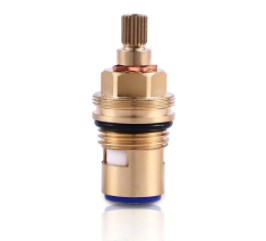The Ceramic Valve Core is widely recognized in the plumbing industry for its exceptional sealing ability and long-term resistance to leakage. Unlike older valve core technologies, such as rubber washers or compression-based mechanisms, the Ceramic Valve Core relies on two precisely machined and polished ceramic discs that slide over each other to control water flow. When these discs align to close the valve, they create an extremely tight seal that effectively blocks water from passing through. This tight seal is the reason why faucets equipped with a Ceramic Valve Core are far less likely to experience dripping or leakage during normal operation.
One of the main reasons leakage is uncommon with a Ceramic Valve Core is the material’s hardness and wear resistance. The ceramics used are typically made from alumina or zirconia, which are highly durable materials capable of withstanding years of mechanical stress without significant degradation. As a result, even after thousands of open and closed cycles, the sealing surfaces remain smooth and intact, allowing them to maintain their watertight function. This durability contrasts with traditional rubber or plastic valve components, which may deform, crack, or wear out over time, leading to gaps in the seal and eventual leaks.
Moreover, the operation of a Ceramic Valve Core does not rely on compression or physical pressure to create a seal. Instead, the flat surfaces of the ceramic discs form a natural barrier to water flow when aligned properly. This design eliminates the need for constant tightening and reduces the chance of user error contributing to wear. With less mechanical strain applied during operation, the core remains in optimal condition longer, which contributes to its excellent resistance to leaks. Additionally, ceramic discs are chemically inert and corrosion-resistant, meaning they are not easily affected by minerals, chlorine, or other common waterborne elements that could degrade other materials.
However, while Ceramic Valve Cores are highly leak-resistant, they are not entirely immune to leakage under all conditions. Improper installation, low-quality manufacturing, or damage caused by foreign particles like sand or scale can compromise the sealing surfaces. In cases where hard debris enters the valve chamber, the ceramic discs may become scratched or chipped, creating microscopic gaps through which water can escape. To avoid this, it is important to ensure proper filtration in the water supply and to use certified, high-quality components during plumbing installations.
In practical use, most cases of leakage associated with a Ceramic Valve Core stem from external factors rather than the failure of the ceramic material itself. For example, worn-out O-rings or seals around the valve housing, improperly tightened connections, or thermal expansion of surrounding materials may create pathways for water to leak. Therefore, when evaluating a leaking faucet, it is essential to inspect not only the ceramic discs but also the complete assembly to determine the true cause of the issue.
In conclusion, the Ceramic Valve Core is designed to offer superior protection against leakage and generally performs this role with high reliability over time. Its strong sealing mechanism, wear resistance, and chemical stability make it a preferred choice in both residential and commercial plumbing systems. While no mechanical component is completely fail-proof, the Ceramic Valve Core, when properly installed and maintained, is among the most dependable solutions available for leak prevention in modern faucets and valves.

